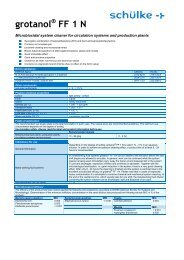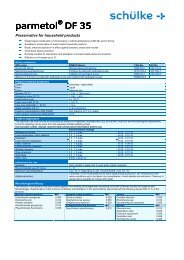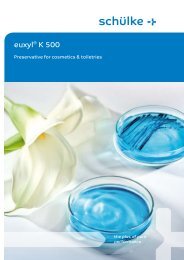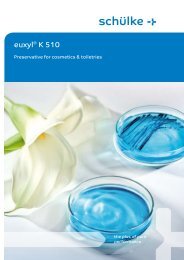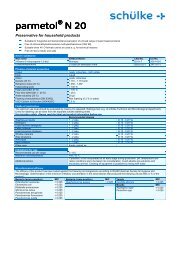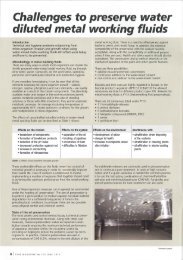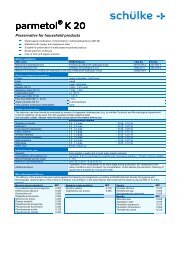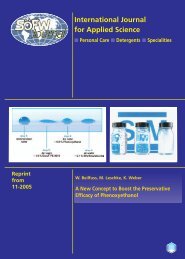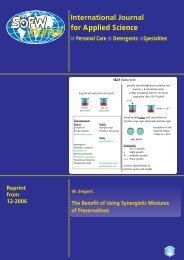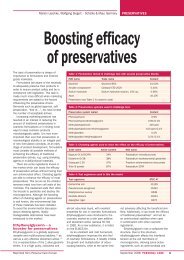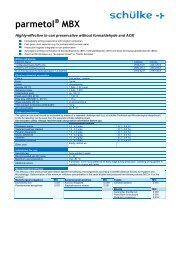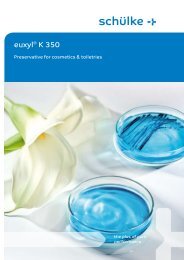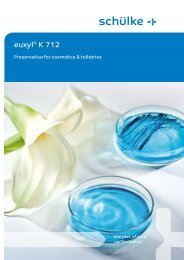ISO 11930 â A Comparison to other Methods to ... - ResearchGate
ISO 11930 â A Comparison to other Methods to ... - ResearchGate
ISO 11930 â A Comparison to other Methods to ... - ResearchGate
You also want an ePaper? Increase the reach of your titles
YUMPU automatically turns print PDFs into web optimized ePapers that Google loves.
COSMETICS<br />
PRESERVATION<br />
they can be tested instead ore in addition<br />
<strong>to</strong> pathogenic species.<br />
The schülke KoKo test includes these microorganisms,<br />
selected using decades of<br />
experience from schülke’s support services<br />
<strong>to</strong> cosmetic producers through the<br />
scope of MQM (Microbiological Quality-<br />
Management). Only the schülke KoKo<br />
test completely fulfil recommendations<br />
of the SCCS Notes of Guidance.<br />
■ Cultivation of<br />
Test Microorganisms<br />
The cultivation of the test germs is comparable<br />
for all methods including the<br />
schülke KoKo test. Fig. 1 shows the procedure<br />
of single-strain cultivation on<br />
agar plates.<br />
Table 3 Microorganisms used for CTFA / M-4 Method for Preservation Testing of<br />
Eye Area Cosmetics<br />
■ Production of Inoculum<br />
For the production of an inoculum, microorganisms<br />
are washed off from the<br />
nutrient media. For the production of an<br />
inoculum, microorganisms are washed<br />
off from the nutrient media plates and<br />
adjusted <strong>to</strong> the required starting germ<br />
count by dilution. The inoculum is then<br />
directly used <strong>to</strong> inoculate the test samples<br />
according <strong>to</strong> <strong>ISO</strong> <strong>11930</strong>, Ph. Eur. 7<br />
and ASEAN. The CTFA tests accepts the<br />
use of either as well pure or mixed culture<br />
suspensions, the schülke KoKo test<br />
uses mixed culture suspensions (i.e. single<br />
cultivated microorganisms brought<br />
<strong>to</strong>gether in<strong>to</strong> a mixed suspension). To<br />
guarantee a constant composition of the<br />
mixed inoculum the mixed suspension is<br />
s<strong>to</strong>red for maximum of three days in a<br />
refrigera<strong>to</strong>r. A new inoculation suspension<br />
is prepared for each inoculation cycle.<br />
■ Inoculation of Samples<br />
The microorganism counts used and the<br />
quantity of the inoculum are demonstrated<br />
in Table 4.<br />
All tests have similar germ loads in the<br />
inoculated sample. The <strong>to</strong>tal germ count<br />
of the inoculum for the schülke KoKo<br />
test was slightly higher <strong>to</strong> ensure safe<br />
preservation <strong>to</strong> compensate for less clean<br />
Fig. 1 Cultivation of test germs for the schülke KoKo Test<br />
production facilities. As there is now the<br />
legal demand <strong>to</strong> produce cosmetic products<br />
according <strong>to</strong> <strong>ISO</strong> 22716 (Guidelines<br />
on Good Manufacturing Practices) (9),<br />
the germ count has recently been adapted<br />
bringing it in<strong>to</strong> line with the <strong>other</strong> test<br />
models.<br />
■ Criteria of Acceptance<br />
<strong>ISO</strong> <strong>11930</strong> (Table 5)<br />
If the formulation meets criteria A, the<br />
microbiological risk is considered <strong>to</strong> be<br />
<strong>to</strong>lerable (the cosmetic product is protected<br />
against microbial proliferation<br />
that may present a potential risk for the<br />
user) and the cosmetic product is deemed<br />
<strong>to</strong> meet the requirements of this International<br />
Standard without additional rationale<br />
(1).<br />
If the formulation meets criteria B, the<br />
microbiological risk analysis shall demonstrate<br />
the existence of control fac<strong>to</strong>rs<br />
not related <strong>to</strong> the formulation; for example,<br />
a protective package such as a<br />
pump provides a higher level of protection<br />
than a jar (see Annex D, <strong>ISO</strong> <strong>11930</strong>).<br />
46 SOFW-Journal | 138 | 7-2012




